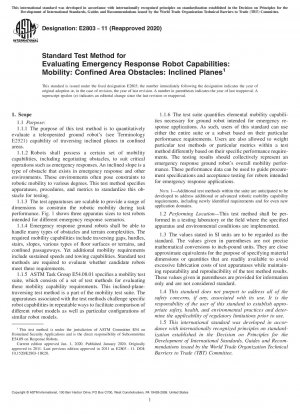ASTM E2803-11(2020)
Standard Test Method for Evaluating Emergency Response Robot Capabilities: Mobility: Confined Area Obstacles: Inclined Planes
- Standard No.
- ASTM E2803-11(2020)
- Release Date
- 2020
- Published By
- American Society for Testing and Materials (ASTM)
- Latest
- ASTM E2803-11(2020)
- Scope
- 1.1 Purpose: 1.1.1 The purpose of this test method is to quantitatively evaluate a teleoperated ground robot’s (see Terminology E2521) capability of traversing inclined planes in confined areas. 1.1.2 Robots shall possess a certain set of mobility capabilities, including negotiating obstacles, to suit critical operations such as emergency responses. An inclined slope is a type of obstacle that exists in emergency response and other environments. These environments often pose constraints to robotic mobility to various degrees. This test method specifies apparatuses, procedures, and metrics to standardize this obstacle for testing. 1.1.3 The test apparatuses are scalable to provide a range of dimensions to constrain the robotic mobility during task performance. Fig. 1 shows three apparatus sizes to test robots intended for different emergency response scenarios. 1.1.4 Emergency response ground robots shall be able to handle many types of obstacles and terrain complexities. The required mobility capabilities include traversing gaps, hurdles, stairs, slopes, various types of floor surfaces or terrains, and confined passageways. Yet additional mobility requirements include sustained speeds and towing capabilities. Standard test methods are required to evaluate whether candidate robots meet these requirements. 1.1.5 ASTM Task Group E54.08.01 specifies a mobility test suite, which consists of a set of test methods for evaluating these mobility capability requirements. This inclined-planetraversing test method is a part of the mobility test suite. The apparatuses associated with the test methods challenge specific robot capabilities in repeatable ways to facilitate comparison of different robot models as well as particular configurations of similar robot models. 1.1.6 The test suite quantifies elemental mobility capabilities necessary for ground robot intended for emergency response applications. As such, users of this standard can use either the entire suite or a subset based on their particular performance requirements. Users are also allowed to weight particular test methods or particular metrics within a test method differently based on their specific performance requirements. The testing results should collectively represent an emergency response ground robot’s overall mobility performance. These performance data can be used to guide procurement specifications and acceptance testing for robots intended for emergency response applications. NOTE 1—Additional test methods within the suite are anticipated to be developed to address additional or advanced robotic mobility capability requirements, including newly identified requirements and for even new application domains. 1.2 Performing Location—This test method shall be performed in a testing laboratory or the field where the specified apparatus and environmental conditions are implemented. 1.3 The values stated in SI units are to be regarded as the standard. The values given in parentheses are not precise mathematical conversions to inch-pound units. They are close approximate equivalents for the purpose of specifying material dimensions or quantities that are readily available to avoid excessive fabrication costs of test apparatuses while maintaining repeatability and reproducibility of the test method results. These values given in parentheses are provided for information only and are not considered standard. 1.4 This standard does not purport to address all of the safety concerns, if any, associated with its use. It is the responsibility of the user of this standard to establish appropriate safety, health, and environmental practices and determine the applicability of regulatory limitations prior to use. 1.5 This international standard was developed in accordance with internationally recognized principles on standardization established in the Decision on Principles for the Development of International Standards, Guides and Recommendations issued by the World Trade Organization Technical Barriers to Trade (TBT) Committee. 1 This test method is under the jurisdiction of ASTM Committee E54 on Homeland Security Applications and is the direct responsibility of Subcommittee E54.09 on Response Robots. Current edition approved Jan. 1, 2020. Published January 2020. Originally approved in 2011. Last previous edition approved in 2011 as E2803 – 11. DOI: 10.1520/E2803-11R20. Copyright © ASTM International, 100 Barr Harbor Drive, PO Box C700, West Conshohocken, PA 19428-2959. United States This international standard was developed in accordance with internationally recognized principles on standardization established in the Decision on Principles for the Development of International Standards, Guides and Recommendations issued by the World Trade Organization Technical Barriers to Trade (TBT) Committee. 1 2. Referenced Documents
ASTM E2803-11(2020) Referenced Document
- ASTM E2521 Standard Terminology for Evaluating Response Robot Capabilities
- ASTM E2592 Standard Practice for Evaluating Response Robot Capabilities: Logistics: Packaging for Urban Search and Rescue Task Force Equipment Caches
ASTM E2803-11(2020) history
- 2020 ASTM E2803-11(2020) Standard Test Method for Evaluating Emergency Response Robot Capabilities: Mobility: Confined Area Obstacles: Inclined Planes
- 2011 ASTM E2803-11 Standard Test Method for Evaluating Emergency Response Robot Capabilities: Mobility: Confined Area Obstacles: Inclined Planes
